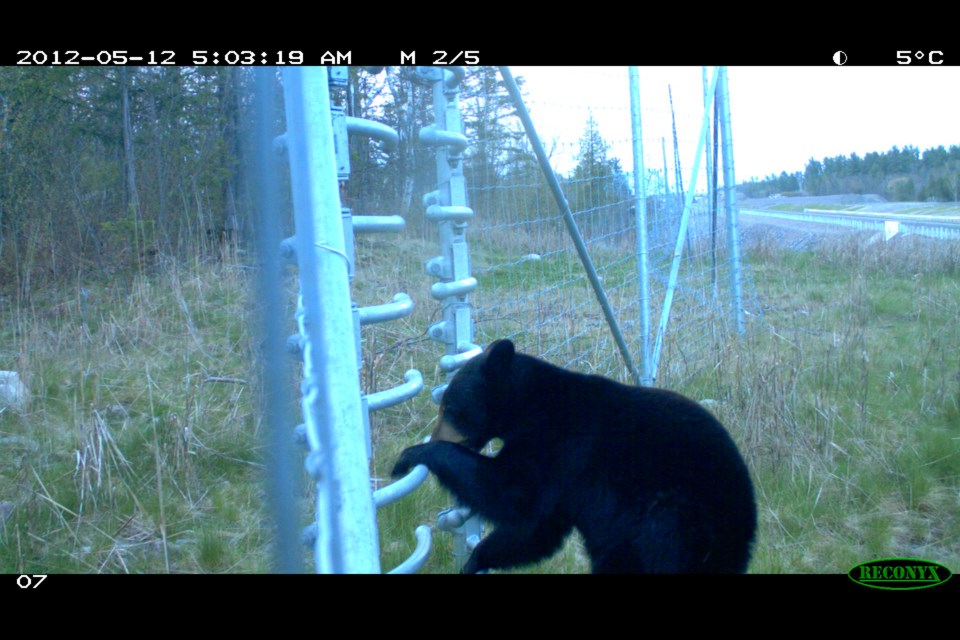Within the writing process, some nature stories are more satisfying to write than others and this is a unique one.
Why do animals cross the road? They always seem to run on to the road at the wrong time. It occurs because wildlife and people driving vehicles are on the roads simultaneously they cannot predict the behaviour of one another. You most likely have had a close encounter of the animal kind. Wildlife collisions are a serious safety concern on Highways 69, 11 and 17. In addition to frequent collisions, there are high severity collisions due to the prevalence of moose along the corridors.
Animal bridges are also known as ecoducts or wildlife crossings. New solutions to wildlife crossing infrastructure are intended to reduce the costs and to tailor each type of crossing to species in various landscape contexts. And they have proven remarkably successful in restoring ecological connectivity and in improving road safety. It started in Alberta (Banff) and the Ministry of Transportation (MTO) followed; there are three examples with good storylines.
Construction of the Highway 69 Burwash overpass began in 2009. It is located 32 kilometres south of Sudbury just before the exit to Killarney, Highway 637; you can’t miss the animal icons, it’s a tourist attraction.
The span of the wildlife bridge is about 80m, and it is 30m wide. It is actually two separate bridges, and it is built using the rock outcrops which is very unique. There is 60cm of topsoil on top and it is landscaped. The final landscaping was completed in the spring of 2012 and has been trimmed. About one kilometre north of the overpass is a large wildlife underpass, constructed at the same time.
Heather Hamel is the communications coordinator, Northeastern Region, MTO. She said between July of 2012 and September of 2019, MTO has documented the following large animal use of the Burwash location: deer (1,358 times), moose (251 times), black bear (188), red fox (105), coyotes (79) and wolves (15). The Burwash Underpass, which is approximately one kilometre north, data was collected between July 2012 and September 2019. During that time, monitoring has documented moose (71), deer (54), coyote (31), red fox (30) and wolf (18) successfully crossing under the highway. There is detailed information about repels vs successful crossings. The wildlife bridge has a very high crossing rate, approximately 95 per cent of the animals that approach will cross. The underpass is closer to 50 per cent.
Solutions
She said there are new investments regarding wildlife fencing.
“As four-laning continues on Highway 69, additional wildlife mitigation measures will be included as identified through the Environmental Assessment process. Construction is currently underway for 15 kilometres of Highway 69 in the French River area, which includes end to end ungulate (i.e. deer, moose) and reptile fencing, four large wildlife underpasses, one joint-use crossing (wildlife/snowmobiles) and seven species at risk crossings for endangered turtles and snakes.
There is also the Wasi Wildlife Underpass, it was completed in 2013, as part of the then Highway 11 reconstruction in that area, just south of the Callander, MTO truck inspection station. The wildlife culvert is two separate, four metre by four metre concrete box culverts, with a median opening to allow light through avoiding a tunnel effect.
Slow down and pull off to the side of the road and look closely at the fence lines. You will spot these interesting turnstiles, those mechanical gates consisting of revolving horizontal arms fixed to a vertical post just like going into the grocery store. And the animals use them to. Wildlife fencing includes one-way escapes as a means for trapped animals to exit the right-of-way. Both the gates and ramps have been used by small numbers of deer and bear. They have not yet been used by moose, though there are fewer moose breaches of the fencing. Some gates have been problematic in allowing deer and bear to move through them both ways. Escape ramps have solved this.
The gates are spring-loaded bars that move independent of one another. The bars will open about 90 degrees and then return to their original position. There are a number of different configurations. One is to have the gate set perpendicular to the fence line. You will also notice that the bars are farther apart near the top. This change was made in hope that it may be more appealing for deer/moose at their head height; good thinking.
Herding cats, don’t let anyone tell you it’s easy. Wildlife crossings really work. Continuous research and monitoring of the wildlife crossing structures will identify future crossings on our major thoroughfares. Why did all these animals cross the road? Probably because they all had very important things to do on the other side. It’s what you'd expect. Some stories make sense and this one piques the interest right from the beginning, naturally.



